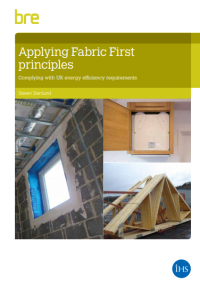Applying Fabric First principles: Complying with UK energy efficiency requirements FB 80
BRE (Building Research Establishment) is an independent, research-based consultancy, testing and training organisation, operating in the built environment and associated industries.
On 31 March 2016, BRE published; Applying Fabric First principles: Complying with UK energy efficiency requirements (FB 80), written by Steven Stenlund.
The 40-page guide provides an understanding of the principles of a 'Fabric First' approach to help developers and house builders design and build homes to meet energy efficiency requirements - including possible future zero carbon or near zero energy homes). It explains how improved thermal performance, examined with reference to SAP 2009 (Standard Assessment Procedure) calculations for a sample housing development, can lead to optimising the fabric design of dwellings.
This includes:
- Position and orientation of dwelling types.
- Fabric improvements.
- Airtightness.
- Thermal bridging.
- Services improvements.
- Developing a standard main specification for application across the site.
The contents of the guide are:
- Executive summary
- Introduction.
- Technical appraisal.
- Determining a site-wide compliance specification.
- Further considerations.
- Appendix: Site scenarios.
[edit] Related articles on Designing Buildings
- Allowable solutions.
- BRE articles on Designing Buildings Wiki.
- BRE Buzz articles on Designing Buildings Wiki.
- BRE Buzz.
- Building Research Establishment.
- Code for sustainable homes.
- Fabric first.
- Fabric first investigation into net zero for existing buildings.
- Fabric first will safeguard heat decarbonisation.
- Passive building design.
- Passivhaus.
- Retrofit.
- Standard Assessment Procedure SAP.
- Zero carbon homes.
- Zero carbon non-domestic buildings.
Featured articles and news
CIOB report; a blueprint for SDGs and the built environment
Pairing the Sustainable Development Goals with projects.
Latest Build UK Building Safety Regime explainer published
Key elements in one short, now updated document.
UKGBC launch the UK Climate Resilience Roadmap
First guidance of its kind on direct climate impacts for the built environment and how it can adapt.
CLC Health, Safety and Wellbeing Strategy 2025
Launched by the Minister for Industry to look at fatalities on site, improving mental health and other issues.
One of the most impressive Victorian architects. Book review.
Common Assessment Standard now with building safety
New CAS update now includes mandatory building safety questions.
RTPI leader to become new CIOB Chief Executive Officer
Dr Victoria Hills MRTPI, FICE to take over after Caroline Gumble’s departure.
Social and affordable housing, a long term plan for delivery
The “Delivering a Decade of Renewal for Social and Affordable Housing” strategy sets out future path.
A change to adoptive architecture
Effects of global weather warming on architectural detailing, material choice and human interaction.
The proposed publicly owned and backed subsidiary of Homes England, to facilitate new homes.
How big is the problem and what can we do to mitigate the effects?
Overheating guidance and tools for building designers
A number of cool guides to help with the heat.
The UK's Modern Industrial Strategy: A 10 year plan
Previous consultation criticism, current key elements and general support with some persisting reservations.
Building Safety Regulator reforms
New roles, new staff and a new fast track service pave the way for a single construction regulator.
Architectural Technologist CPDs and Communications
CIAT CPD… and how you can do it!
Cooling centres and cool spaces
Managing extreme heat in cities by directing the public to places for heat stress relief and water sources.
Winter gardens: A brief history and warm variations
Extending the season with glass in different forms and terms.
Restoring Great Yarmouth's Winter Gardens
Transforming one of the least sustainable constructions imaginable.

























